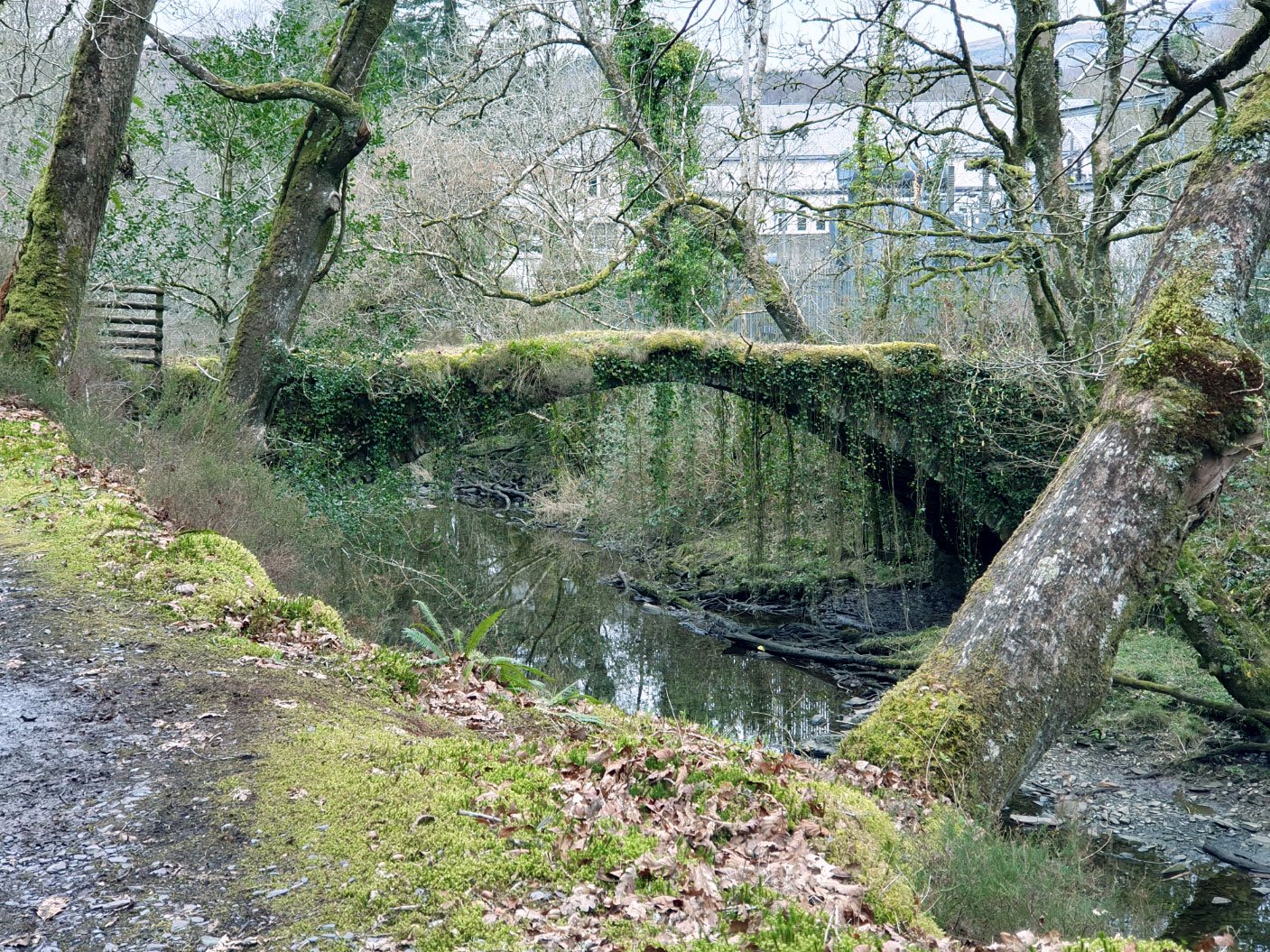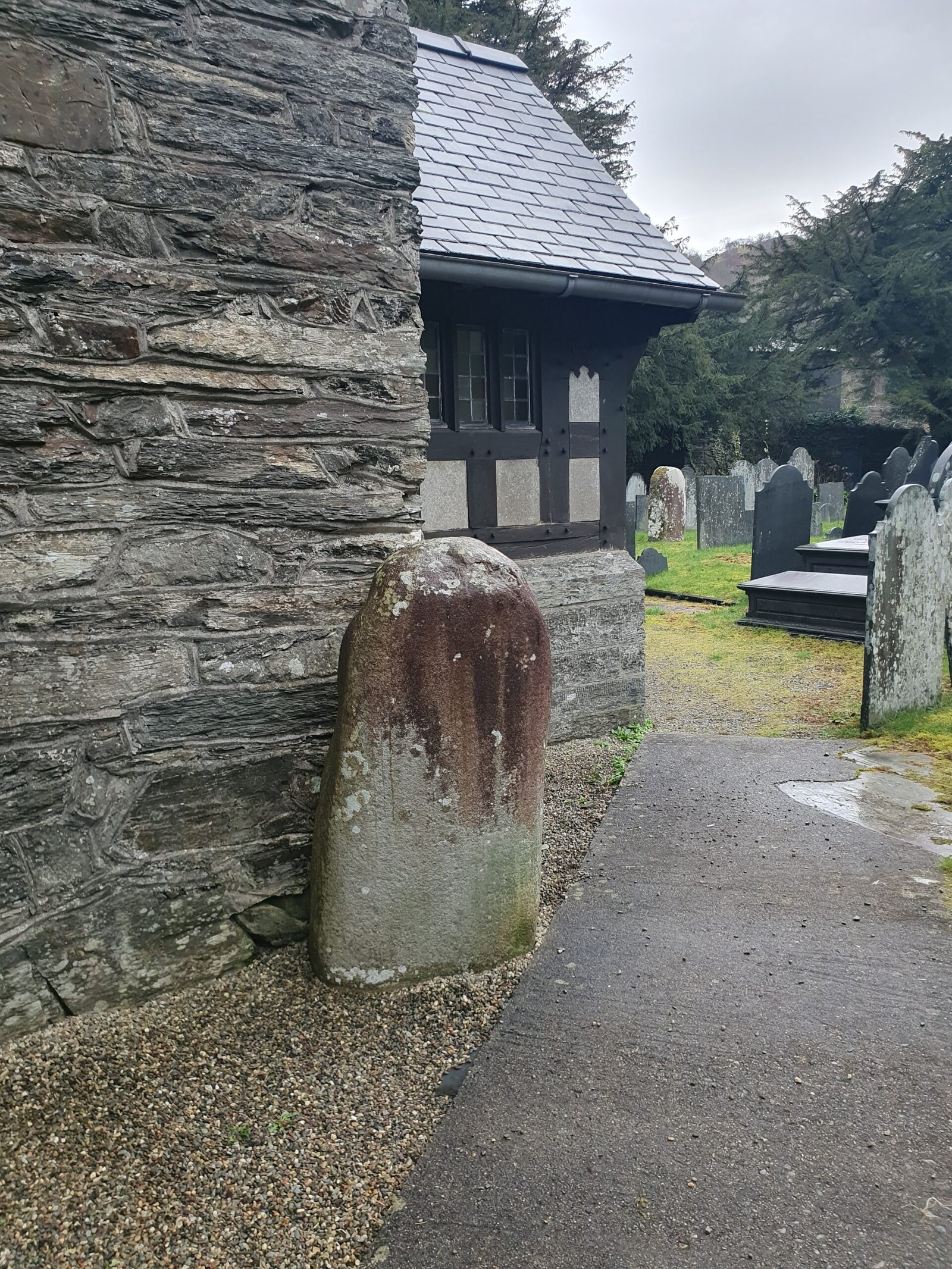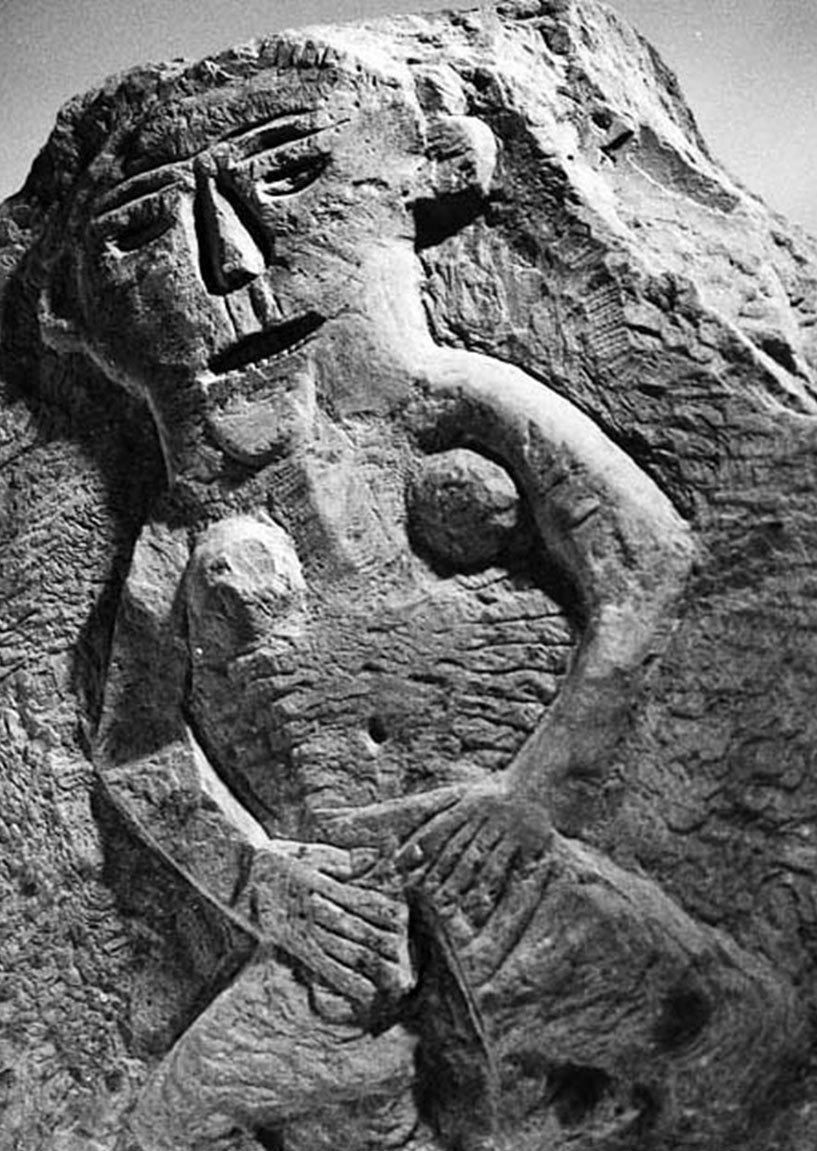Monstrous Women and Magic Mushrooms: Autumn Equinox 2023
Perhaps St Twrog was looking for a place to build his third church as he journeyed along the old Roman road, Sarn Helen,[i] for at the ford crossing the Afon Dwyryd (at present-day Maentwrog) he found what he needed to begin construction of a basic cell, a place to live while his larger plans bore fruit. Withies grew in abundance and could be woven quickly, while the marsh provided plenty of mud, clay or animal dung: together they make wattle and daub, an immediate reminder of history lessons to generations of British schoolchildren.

A bridge on the old road to Harlech
What he may not have expected was to come across the locals worshipping what is variously described as a “demoness” or “she-devil” at an altar there. Ordering the monstrous female to leave at once had no effect and the two fought, wrestling for half a day, but neither could gain the advantage. At length, they agreed a short truce and Twrog climbed up into the Moelwynion, central Snowdonia mountains which do rather loom over the village, and there he prayed and rested to regain his strength.
Again, he got more than he bargained for: an angel appeared, led him to a clearing where a fairy ring of mushrooms grew and bade him eat. Almost immediately Twrog felt his strength and eyesight improve enormously; he could see his adversary far down in the valley below. Easily hefting a huge boulder he hurled it down into the village, where it landed right on target, demolishing the altar and landing, it’s said, between the thighs of the “she-devil”. The “demoness” flew away towards England where some say she ruled at that time.[ii] And there the boulder stands to this day, complete with the handprint of the saint. Perhaps Twrog really was a giant, as some have suggested. There is also a belief that if you rub the boulder in the churchyard you’re fated to return to Maentwrog – the name means Twrog’s Stone – in the future.

Twrog’s Stone near the church door
We don’t know a great deal about Twrog, except that he was, perhaps, one of many sons of Ithel Hael, a prince of Brittany, and that he was a contemporary of St Beuno, who died in the early 7th century CE; giving us an idea of Twrog’s own dates. We do have his feast day, 26 June.
Perhaps feats of strength and magic were required during the Age of Saints in Wales, a time when many Celtic Christians travelled the Atlantic seaways to spread the gospel. Sainthood in Wales did not require canonization by the Roman Church but was simply conferred by local custom: the large number of place names beginning with “llan” and usually followed by the name of a local saint gives us an idea of just how many such saints there were! Llan is usually translated as “enclosure” but I believe “sanctuary” fits as well, if not better.
Maentwrog church, today dedicated both to St Twrog and the Virgin Mary, is attractive although rather dark inside due to the nearby mountains. The stained glass window nearest the door has a representation of Twrog with his left hand on the boulder and a scroll in his right – the latter generally taken to mean holy wisdom, or perhaps represents him as a missionary.
Many scholars no longer use the term “Dark Ages” to refer to the period between the withdrawal of Rome in 410 CE and the Norman Conquest, as it has been widely misunderstood; “dark” actually alludes to our ignorance of the period rather than to any cultural or intellectual lack in its people. But there is a dreamlike, mythical feel to the times and to many of the stories that have come down to us, so that there doesn’t seem to be any problem with the common presentation of another tale of Twrog’s stone as contemporaneous: that the stone marks the grave of Pryderi fab Pwyll, or Pryderi, king of Dyfed and son of Rhiannon and Pwyll, whom we know from the first branch of the Mabinogi.
Pryderi was killed, we’re told, in single combat with Gwydion, the magician nephew of Math, son of Mathonwy; you can find this story in the Mabinogi’s fourth branch. Gwydion had engineered the conflict by tricking Pryderi into handing over some otherworldly pigs in return for a number of mighty war horses – but on checking his stables the following morning the king found no steeds but a healthy crop of magic mushrooms, no doubt thriving in the inevitable manure. The fight between Gwydion and Pryderi was agreed to prevent more bloodshed among their men, but it’s said that Gwydion triumphed through his magic arts.
Mythic truth is different to that of everyday reality, but these stories do invite analysis, with “she-devil” immediately suggesting to me the worship of a local goddess, whose name we may never know. That the boulder should have come to rest between her thighs is fascinating and a number of possibilities come to mind, the first being simple mysogyny, common in the early – and later – Christian church. Perhaps the “demoness” represented a type of Sheela-na-Gig figure, although very few of these are found in Wales.[iii] It is worth remembering that perhaps most people didn’t have chairs or even stools, and women who had to cook and grind grain may have squatted for hours every day, so this would have been a very normal posture for them. Could the boulder thrown at the “demoness” have symbolically closed that terrifying portal between the thighs of the Sheela, discouraging too much thought about the unknown place we all arrive from, and through which we must metaphorically depart? Or could the boulder have been intended – again, symbolically – to prevent any future sexual pleasure and even restore a kind of virginity?
Tales of giants flinging stones around are common in Celtic lands and beyond, with a number of the stones said to retain an impression of the giant’s fingers, just as Twrog marked his boulder. In Scotland, the Cailleach Bheur is often said to have built the landscape and in many other tales giants cart boulders around in their aprons – a garment which, it should be noted, usually serves to cover the thighs. Cairns and moraines (rocks left over from a melted glacier) are often named with some variant of the “Giantess’s Apronful”, so that a group of cairns on the south-western slopes of Tal-y-Fan, Gwynedd[iv], has exactly that name. They’re found in Yr Hen Ogledd,[v] too – I remember asking about a place called “Apronful” between Clitheroe and Sabden in Lancashire, probably a grave mound, as a child, and being told the story of the giantess – my father did like to add that there was a treacle mine at Sabden, if you could only find it!
It’s also worth noticing that Twrog’s feast day is close to the Summer Solstice, often celebrated in the past with bonfires and rolling huge fiery wheels down hills. At Cooper’s Hill in Gloucestershire a Double Gloucester cheese weighing up to nine pounds is set rolling down the 200 metre hill, and people come from all over the world to race after it, more, these days, for bragging rights than the cheese! The date for the event has shifted to a nearby bank holiday, but the similarities are suggestive. Another food worth considering here is the magic mushroom[vi], the appearance of which in both variants of the Maentwrog story may stress its importance. Now a Class A drug in Britain, it’s illegal to gather the mushrooms but images of them are seen in Stone Age rock art, perhaps indicating shamanic ritual or – just like today – as recreational drugs. We still tell children stories in which special mushrooms are eaten, notably in Alice in Wonderland where our heroine is told to nibble at a mushroom to grow taller or shorter, as needed.[vii] Would an angel suggest consuming psilocybin?
It seems likely that the story of Twrog and the demoness is a Christian retelling of a far older tale, perhaps of a fight between two giants hurling rocks across the Vale of Ffestiniog, or simply of Goddess creating the landscape, as in so many other legends. According to Remy Dean’s “Folklore Thursday” blog, the stone probably marked a ford, a safe crossing through these marshy lands, or perhaps was a territorial marker, adding: “… some say attended by a priestess who, for a small tribute, would bless travellers and ensure they had a safe journey across the valley.”[viii]
I was planning a climb into the surrounding hills to view Maentwrog from the saint’s point of view when I discovered that only just down the road is some of Britain’s most ancient woodland, which the Royal Geographical Society calls the Celtic rainforest, noting that this relatively unpolluted area allows some very rare lichens and mosses to survive. I changed my plans to climb up through these woods, almost to the same height. Known as Coed Felinrhyd, the woodland’s most ancient trees and plants are in a gorge at its edge, where the Afon Prysor, complete with a waterfall known as Rhaeadr Du, provides enough moisture to ensure a real, dripping rainforest, which the RGS suggests has the same species growing here since they first colonised after the last Ice Age ended around 10,000 years ago. Magic, indeed.
And no, I didn’t find any magic mushrooms, not that I was looking, of course!
Geraldine Charles, 21 September 2023
[i] Now the B4410 road
[ii] Many thanks to Twm Elias, local historian and folklorist, formerly at Plas Tan y Bwlch – personal communication.
[iii] I know only of two Sheelas in Wales – the one pictured, from Llandrindod Wells, and a badly worn one at Penmon in Anglesey.
[iv] http://www.stone-circles.org.uk/stone/giantessapronful.htm accessed 8 March 2023
[v] The Old North, where people once spoke a variety of Old Welsh, including much of northern England and some of the southern Scottlish lowlands
[vi] Psilocybe semilanceata
[vii] Readers of a certain age may be instantly reminded of Jefferson Airplane’s “White Rabbit” (1967), as I certainly was!
[viii] https://folklorethursday.com/folklore-of-archaeology/welsh-folklore-maentwrog-significance-stone/ accessed 8 March 2023

St Twrog

Sheela-na-Gig found buried under the threshold of Llandrindod Wells Old Parish Church

